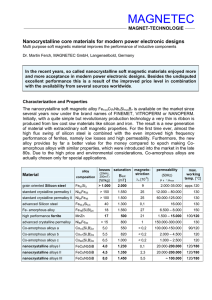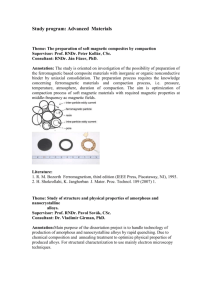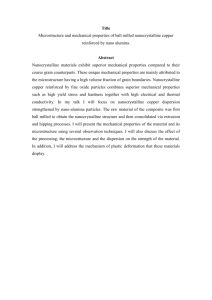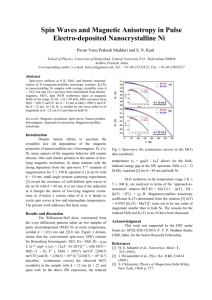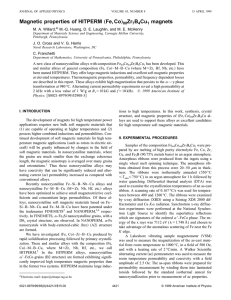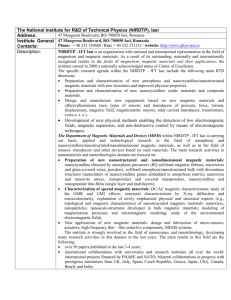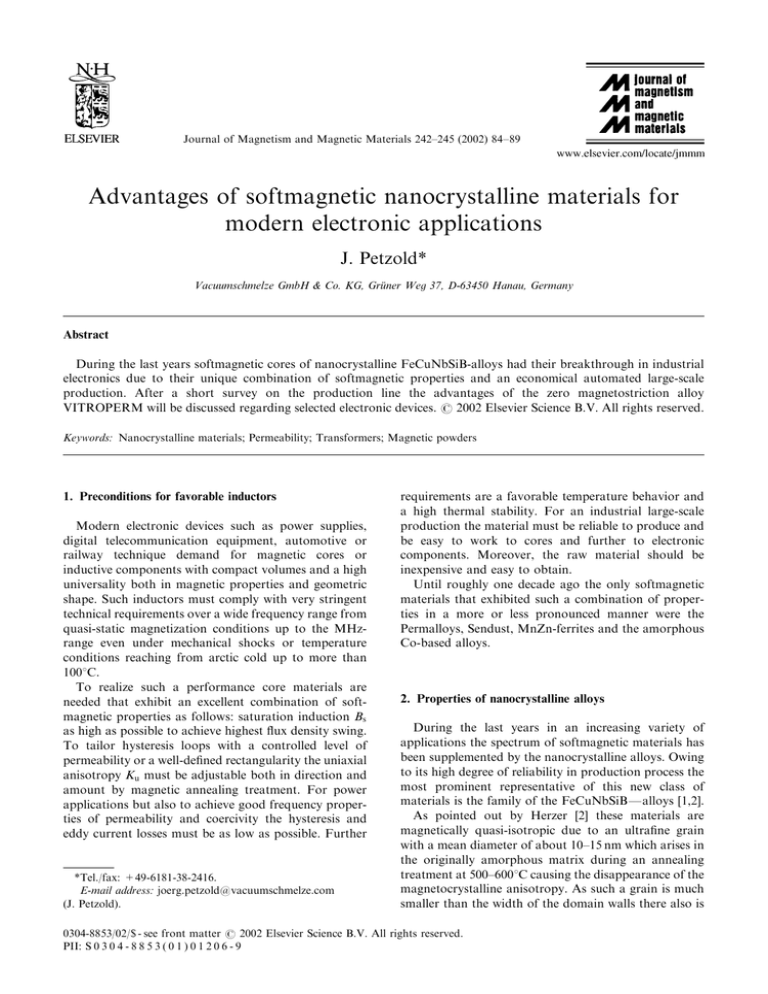
Journal of Magnetism and Magnetic Materials 242–245 (2002) 84–89
Advantages of softmagnetic nanocrystalline materials for
modern electronic applications
J. Petzold*
Vacuumschmelze GmbH & Co. KG, Gruner
Weg 37, D-63450 Hanau, Germany
.
Abstract
During the last years softmagnetic cores of nanocrystalline FeCuNbSiB-alloys had their breakthrough in industrial
electronics due to their unique combination of softmagnetic properties and an economical automated large-scale
production. After a short survey on the production line the advantages of the zero magnetostriction alloy
VITROPERM will be discussed regarding selected electronic devices. r 2002 Elsevier Science B.V. All rights reserved.
Keywords: Nanocrystalline materials; Permeability; Transformers; Magnetic powders
1. Preconditions for favorable inductors
Modern electronic devices such as power supplies,
digital telecommunication equipment, automotive or
railway technique demand for magnetic cores or
inductive components with compact volumes and a high
universality both in magnetic properties and geometric
shape. Such inductors must comply with very stringent
technical requirements over a wide frequency range from
quasi-static magnetization conditions up to the MHzrange even under mechanical shocks or temperature
conditions reaching from arctic cold up to more than
1001C.
To realize such a performance core materials are
needed that exhibit an excellent combination of softmagnetic properties as follows: saturation induction Bs
as high as possible to achieve highest flux density swing.
To tailor hysteresis loops with a controlled level of
permeability or a well-defined rectangularity the uniaxial
anisotropy Ku must be adjustable both in direction and
amount by magnetic annealing treatment. For power
applications but also to achieve good frequency properties of permeability and coercivity the hysteresis and
eddy current losses must be as low as possible. Further
*Tel./fax: +49-6181-38-2416.
E-mail address: joerg.petzold@vacuumschmelze.com
(J. Petzold).
requirements are a favorable temperature behavior and
a high thermal stability. For an industrial large-scale
production the material must be reliable to produce and
be easy to work to cores and further to electronic
components. Moreover, the raw material should be
inexpensive and easy to obtain.
Until roughly one decade ago the only softmagnetic
materials that exhibited such a combination of properties in a more or less pronounced manner were the
Permalloys, Sendust, MnZn-ferrites and the amorphous
Co-based alloys.
2. Properties of nanocrystalline alloys
During the last years in an increasing variety of
applications the spectrum of softmagnetic materials has
been supplemented by the nanocrystalline alloys. Owing
to its high degree of reliability in production process the
most prominent representative of this new class of
materials is the family of the FeCuNbSiBFalloys [1,2].
As pointed out by Herzer [2] these materials are
magnetically quasi-isotropic due to an ultrafine grain
with a mean diameter of about 10–15 nm which arises in
the originally amorphous matrix during an annealing
treatment at 500–6001C causing the disappearance of the
magnetocrystalline anisotropy. As such a grain is much
smaller than the width of the domain walls there also is
0304-8853/02/$ - see front matter r 2002 Elsevier Science B.V. All rights reserved.
PII: S 0 3 0 4 - 8 8 5 3 ( 0 1 ) 0 1 2 0 6 - 9
J. Petzold / Journal of Magnetism and Magnetic Materials 242–245 (2002) 84–89
Initial permeability, µi
10 6
nanocrystalline
(Fe-base)
permalloys
10 5
Sendust
10 4
MnZnFerrites
amorphous
(Co-base)
10 3
0.5
1.0
Saturation magnetization, JS [T]
1.5
Fig. 1. Typical initial permeabilities and saturation inductions
for low magnetostrictive softmagnetic materials [2].
no pinning by the grain boundaries so that the domain
wall motion is not hindered at all. Another immediate
consequence of the nanocrystalline two-phase-structure
is a rather low magnetostriction of ls p10 ppm, which is
much lower than in the as quenched still amorphous
state [2]. In certain compositions as for example
FebalCu1Nb3Si15,5B7 even zero magnetostriction can be
obtained and with this magnetoelastic anisotropies are
annihilated. As such a composition is highly interesting
under magnetic and technological aspects said alloy
is industrially produced on a large scale e.g. by
VACUUMSCHMELZE and can be obtained commercially under the trade name VITROPERM.
With the simultaneous disappearance of crystalline
and magnetoelastic anisotropies the most important
conditions for excellent F- or Z-loops with lowest
uniaxial field induced anisotropy are fulfilled. Further,
in nanocrystalline FeCuNbSiB-alloys field induced
anisotropy arises from the directional ordering of
FeSi-atom pairs as in a-FeSi single crystals [2]. By this
the kinetics is considerably slower than in amorphous
materials and in consequence, as Fig. 1 shows, despite of
a rather high saturation magnetization of Js E1:2 T
lowest field-induced anisotropies can be realized in a
defined manner that results in highest permeabilities but
with significant better thermal stability than in amorphous alloys or even in crystalline permalloys.
3. Production process for cores
The initial material is produced as an amorphous
ribbon via rapidly solidification technology. In the
meantime this technique is well established for largescale production, so that the quantity of worldwide cast
85
FeCuNbSiB-alloys has grown to an order of magnitude
of approximately 1000 tons/year.
Related to application frequency the ribbon thickness
(which is responsible for lowest eddy current losses) can
be varied between 15 and 25 mm while its width can be
adjusted between roughly 1 and 100 mm.
To prevent an increase of the eddy current losses in
the later inductor the ribbon surface is isolated by a thin
mineral layer, which consists typically of MgO. Afterwards the ribbon is wound to toroidal strip wound cores
just in their final dimension whereby the outer diameter
can be varied between about 2 mm and several hundreds
of millimeters. On automatic machines winding can be
performed free of mechanical stress and flux controlled
with a core size-dependent output rate up to several
hundred thousand pieces per month.
The wound cores are stabilized by spot welding and
stacked in a gluing magazine preparing a two step
annealing treatment in a batch furnace equipped with
facilities for generating strong magnetic fields oriented in
the axial and tangential direction of the cores.
During the first annealing stage which is performed at
a temperature between 5401C and 5801C the nanocrystalline phase arises. In this state the material exhibits a
round hysteresis loop with a remanence to saturation
ratio of typically about 50% combined with a high
initial and a high maximum permeability which can rise
up to values of several hundred thousands.
To gain flat or rectangular hysteresis loops on which
we focuse here, a second annealing stage has to be
performed under a magnetic field which must be
strong enough to saturate the material at all. Thus a
controlled uniaxial anisotropy Ku will be induced
depending both on the orientation of the field relative
to the axes of the wound ribbon and on the annealing
temperature.
If the anisotropy stands perpendicular to the ribbon
axes a flat loop will arise whereby the initial permeability
can be definitely adjusted even by large-scale production
in a considerable wide range between about 15,000 and
150,000 by a simple variation of the field annealing
conditions. Simultaneously the ratio of remanence to
saturation BR =BS changes between about 2% and 10%
depending on the ratio Ku =Kdisturb ; (Kdisturb =sum of
superimposed disturbance anisotropies) which for good
linearity properties should be much greater than one. If
in contrast induced anisotropy lies parallel to the
ribbon axes, the resulting loop is Z-shaped. In this
case a ratio of BR =BS -100% is desired whereby in
industrial practice values of BR =BS can rise up to more
than 90%.
Finally the magnetic properties of each single core are
measured by a computer controlled testing sequence. If
the core complies with customer’s specification it will be
encapsulated or epoxy coated, labeled and made ready
for shipment.
86
J. Petzold / Journal of Magnetism and Magnetic Materials 242–245 (2002) 84–89
tion of the output voltage. As for the maximum
transferable power Pmax holds Eq. (1)
4. Applications for nanocrystalline cores
Due to their unique combination of favorable magnetic
properties nanocrystalline cores are now well established
in a wide field of applications [3–5], of which the most
important are summarized in Table 1. The major areas
are: switched mode power supplies, digital telecommunications with emphasis on ISDN systems, installation
techniques at 50/60 Hz and since very recently applications in the automotive electronics. Additionally particle
accelerators should be mentioned where cores with
masses up to 50 kg or even more are needed for
converters or resonators. In the following paragraphs
some selected applications where nanocrystalline material
offers particular benefit will be discussed.
Pmax pf DBopt AFe
ð1Þ
4.1. Power supplies
increasing values of frequency f and optimal flux density
swing DBopt allow a reduction in volume (here represented by the iron cross section AFe ), weight and price of
the transformer inversely. In Eq. (1) clock frequency f is
limited by the losses of the power IGBTs and the
transformer material. As shown by Eq. (2) DBopt will be
limited thermally by the maximum overheating temperature DT and by the core losses where P0 stands for
those losses arising at a certain reference induction swing
B0 ; which scales with saturation induction.
sffiffiffiffiffiffiffi
DT
:
ð2Þ
DBopt pB0 P0
Since several years nanocrystalline materials are well
established in the essential types of components for
switched-mode power supplies (SMPS) covering a wide
range of transferable energy reaching from less than
100 W for PC-applications up to clocked high power
inverters for modern railway driving device with an
output power of more than 1 MW. Such components are
power transformers, common mode RFI chokes in
filters to prevent noise emission and to protect the device
against interference, magnetic amplifiers, and storage
chokes and spike killers to suppress output voltage
noise.
In power supply units the power transformer is the
central and most costly component. Its basic function is
the galvanic isolation between the primary and the
secondary side of the device as well as the transforma-
As Fig. 2 shows, just in the regime of the operating
frequencies of IGBT power semiconductors of 10–
50 kHz nanocrystalline VITROPERM-alloys are superior to other transformer materials by exhibiting losses
close to the ideal value of the classical eddy current
theory [9]. This property combined with an upper
operating temperature of more than 1201C and a high
saturation induction of Bs E1:2 T gave an essential
impetus for the implementation of clocked power supply
topologies in the upper power range from a few kW for
battery charging or medical or industrial applications up
to the regime of MW in the field of modern railway
traction techniques.
Furthermore the low negative temperature coefficient
should be mentioned. This property protects the
transformer from overheating and guarantees reliable
Table 1
Main applications for nanocrystalline alloys
Application area
Application
Material requirements
Power supplies
Power transformer [4,5]
Common mode choke [4,6]
Storage choke [7]
PFC-choke [7]
Drive transformer [4]
Magnetic amplifier [8]
Pulse power core [4]
Pfe ; Bs
mðf Þ; Bs
mðHDC Þ; Bs ; Pfe
mðHDC Þ; Pfe
Pfe ; linearity
DBRS ; Pfe ; Bs
Bs ; Pfe
ISDN telecomm.
Signal transformer S0 [4]
Common mode choke [4,6]
mðf Þ; mðHDC Þ
mðf Þ; Bs
Installation techniques
Earth leakage circuit breaker
(AC-sensitive) [4]
Earth leakage circuit breaker
(Pulse sensitive) [4,5]
Current transformer [4,5]
mi ; mmax ; mðTÞ; Bs
mi ; Bs ; linearity
DC/DC-Converter [7]
mðHDC Þ; Bs ; Pfe (flakes!)
Automotive electronics
mi ; mðTÞ; Pfe ; Bs ; linearity
J. Petzold / Journal of Magnetism and Magnetic Materials 242–245 (2002) 84–89
200
100
^
FebalCu1Nb3Si15,5B7
Mn-Zn ferrite
(Siferrit N67)
10
Amorphous
(Co- based)
1
Nanocrystalline
(VITROPERM)
Eddy current
theory
0.1
Core Losses, Pfe [W/kg]
(f = 100 kHz, B^= 0.2 T)
60% NiFe (70 µm)
B = 0.1 T
Core losses, Pfe [W/kg]
87
150
Tan
100
50
0
10
20
Frequency, f [kHz]
50
100
Fig. 2. Comparison of magnetization losses of typical materials
for power transformers.
operation at intrinsic temperatures of 401C up to
1201C. The consequence is a further reduction of volume
finally resulting in a weight to power ratio of only a few
hundred g/kW which is smaller than a factor of 30 as it
is typical for crystalline transformer materials.
For the application in personal computers or industrial devices SMPS with an output power range up to
1 kW are demanded. Generally such devices are featured
by multiple independent regulated output voltages
stabilized by a magnetic amplifier (MagAmp) containing
a core with a rectangular hysteresis loop which acts as
saturable choke as follows: As long as the working point
remains in the steep region of the loop the current is
blocked by the inductor. However, as soon as the choke
is magnetized to saturation its impedance decreases
abruptly by several orders of magnitude and the choke
becomes conductive. Depending on the duration ratio of
the blocking to conducting time a pulse width regulation
can be realized by which the output voltage is stabilized
fast and exactly against abrupt changes of the external
load.
For good regulation characteristics a MagAmp core
needs a residual flux density swing DBRS from remanence to saturation induction as small as possible which
requires that Ku bKdisturb is fulfilled. Moreover, due to a
high clock frequency range of typically 100–300 kHz the
core losses must be as low as possible. However, a high
amount of Ku oriented parallel to the ribbon axes
excludes low magnetization losses because there exists a
strong dependence of the anomalous eddy current losses
from the domain wall energy [10]. This conflict can only
be solved by minimizing Kdisturb by the simultaneous
elimination of the magnetocrystalline and magnetoelastic anisotropy as can be reached e.g. in amorphous Cobased alloys or in nanocrystalline alloys as VITROPERM. Therefore Fig. 3 shows rather low losses over a
wide range of DBRS ; whereby an optimum can be
reached by appropriate annealing conditions. Additional advantage comes from the high saturation
0
50
100
150
200
250
300
Residual flux density swing, ∆BRS [mT]
Fig. 3. Balance between magnetization losses and residual flux
density swing in MagAmp cores of VITROPERM Z for varied
field annealing temperature Tan :
S0- Bus
Network termination
Terminal Equipment
R-Fe
L
|Z|
Cw
2500 Ω
400 Ω
250 Ω
cm
1
Impedance template
2kHz
20kHz
160kHz 1MHz
f
Fig. 4. Impedance template and S0 -transformers and EMCchokes in ISDN telecommunication network terminator and
terminal equipment.
induction facilitating a high flux density swing DB
which in combination with an extended temperature
range up to 1201C allows a significant reduction in core
weight, volume and costs compared to other MagAmp
materials e.g. the Co-based amorphous materials or
ferrites.
4.2. Digital telecommunications
During the last decade ISDN telecommunication
network has been well established in many countries of
the world. As Fig. 4 shows the network termination as
well as the terminal equipment like telephone, telefax,
PC, etc. are connected to the S0 -bus by S0 -transformers
J. Petzold / Journal of Magnetism and Magnetic Materials 242–245 (2002) 84–89
88
to get galvanic isolation. Furthermore EMC-chokes [6]
are used to suppress RFI noise.
The basic requirements for S0 -transformers are
compliance with an impedance template as sketched in
Fig. 4 even under DC-bias currents coming from
electrical remote supply, which guarantees operation of
consumer terminal equipment even under a local current
failure. As in digital telecommunication devices the
degree of integration advances increasingly, the volume
of the components and in consequence the core size
must be as compact as possible.
Said requirements can only be fulfilled simultaneously
if the core material shows highest permeabilities
up to high frequencies combined with a high stability
against DC-premagnetization fields whereby the
second precondition needs a F-shape loop with pronounced linearity and a high saturation induction.
However, as already shown in Fig. 1 for amorphous
alloys this condition stands in contradiction to
the requirement for a high permeability and in
consequence regarding core size compromises have to
be accepted.
As can be derived from Fig. 5 these problems can be
solved again by VITROPERM in an excellent manner.
Despite of a high saturation induction which favors a
higher stability against DC-premagnetization than can
be realized by amorphous alloys or ferrites, the initial
permeability e.g. at 10 kHz can be varied definitely
between a lower limit of about 15,000 and upper values
near 100,000 by a variation of the annealing conditions.
This again allows further reduction in core size and
makes the component very interesting concerning circuit
design and marketing aspects. In consequence S0 transformers with VITROPERM have turned out to
be a serious competitor for amorphous cores and ferrites
with an increasing market share of several millions of
pieces per month.
4.3. Installation techniques
Besides differential-current transformers for pulse
current sensitive earth leakage circuit breakers that are
discussed e.g. in Ref. [5], presently current transformers
for electronic energy meters are the major application in
the field of 50/60 Hz-technique for high permeability
nanocrystalline cores with flat hysteresis loop.
In electronic electricity meters for the 50/60 Hz AC
power supply the calculation of the power consumption
is realized by continuously multiplying the values of the
detected current and voltage at any time. To achieve a
reasonable precision even in circuits with a mainly
inductive load the requirements on the phase error of the
current transformer are rather high. Thus, the quality of
the transformer can be described by the ratio ðRCu þ
Rload Þ=oL [9] (RCu ; Rload : ohmic resistance of secondary
winding and load; L: (pm) inductance of the secondary
side of the current transformer) which is proportional to
the phase shift j and should be as small as possible.
In consequence the core material has to show over a
wide range of induction highest and constant permeability as well as smallest magnetization losses. As can
be seen from Fig. 6 the error of amplitude FðIÞ of
VITROPERM can be neglected. Moreover, the high
constancy of the phase error tanj vs. Iprim curve makes
it possible to reduce the phase error by more than a
factor 4 by an electronic calibration of the evaluation
system. This is a special advantage of the high linearity
of the hysteresis loop which is a unique feature of
VITROPERM and amorphous alloys with zero magnetostriction.
4.4. Automotive electronics
New developments in automotive electronics as for
example 1 kW DC/DC-converters for the 14/42 V dual
1000000
0.25
VITROPERM
(µ≅ 45,000)
VITROPERM
(µ≅ 15,000)
10000
VC 6030 F
VC 6150 F
VC 6200 F
VC 6125 F
1000
100
0.15
tan ϕ
100000
10 kHz
VITROPERM
0.05
PERMALLOY
- 0.05
F(I) [%]
VITROPERM
(µ≅ 72,000)
Amplitude error, F(I) [%]
Phase error, tan ϕ
Permeability, µ(HDC )
VC 6025 F
VC 6070 F
- 0.15
1
10
100
1000
10000
100000
Bias field, HDC [mA/cm]
Fig. 5. Permeabilty vs. DC-premagnetization curves of nanocrystalline cores with varied permeability (VITROPERM) in
comparison with amorphous Co-based alloys (VC=VITROVAC).
0.1
1
10
Primary current, Iprim [A]
100
Fig. 6. Transformer characteristics calculated from typical
material data. Core dimensions: 16 10 6; Nprim ¼ 1; Nsec ¼
4000; diam Cu=0.07 mm; Rload ¼ 200 O
J. Petzold / Journal of Magnetism and Magnetic Materials 242–245 (2002) 84–89
89
5. Conclusions
Fig. 7. Design study for molded components [7]: 1. Filter choke
with integrated connectors; 2. Heat sink mountable choke; 3.
Air gap free planar choke; 4. Pot core like design.
voltage system call for chokes with high storage energy,
optimized design in shape, lowest losses and favorable
thermal properties. This can be fulfilled in principle by
air gapped cores with low permeability but also by
powder cores as e.g. Sendust revealing excellent losses
and representing the special case of a distributed air gap.
Recently the latter group has been supplemented by
nanocrystalline flake cores consolidated by press additives [11]. By a variation of the particle size and the
compacting conditions the permeability can be adjusted
with good reproducibility between about 10 and several
thousands.
Now under development are chokes made from
nanocrystalline flake powder molded complete with
copper coil and a high temperature plastic resin to the
final shape of the component.
One of the most important advantages of this
procedure is that the properties of the initial material
as high saturation induction or lowest coercivity and
core losses remain unchanged. Typical values of the low
frequency permeability are about 50 whereby the
frequency dependent release up to 1 MHz is less than
10%. Regarding the losses the molded component of
nanocrystalline flakes can be classified between powdercores of Molypermalloy [12] and Sendust [13].
An additional advantage is that this new technology
makes use of almost the whole component volume for
the magnetics, allows a fully automated production
process and as Fig. 7 shows opens a high variety of
shapes and designs. Moreover, molded chokes are
excellent for use in heat sink applications. In contrast
to normal components with a simple compound of resin
the high thermal conductivity of VITROPERM-powder
component insures good coupling between the magnetic
materials, copper windings and heat sink. Thus compared to classic solutions the temperature rise can either
be reduced or the design will result in a reduction of
volume by 40% or even more.
As pointed out by selected examples, due to their
unique combination of softmagnetic properties and a
high thermal stability nanocrystalline VITROPERM
alloys comply with the fundamental requirements for
high performance inductors for a wide range of modern
electronic devices in a unique manner. The major benefit
of this class of hightech materials is a miniaturization of
the inductors in volume combined with a high degree of
universality in shape and electric properties. This allows
a reduction in size for the complete device and in many
cases solutions being impossible with conventional
magnetic alloys. On the other side the reliability and
cost optimization of the production process brought the
price of the product in a range being highly competitive
with classical crystalline alloys and ferrites. In consequence increasing demand arises from market pushing
the worldwide production rate in the range estimated to
1000 tons/year with growing tendency.
Acknowledgements
.
The author is grateful to W. Gunther,
M. Brunner
and W. Loges for support with results concerning
MagAmp cores and molded components as well as to
N. Preusse and D. Heumann for valuable suggestions.
References
[1] Y. Yoshizawa, S. Oguma, K. Yamauchi, J. Appl. Phys. 64
(1988) 6044.
[2] G. Herzer, Nanocrystalline soft magnetic alloys. in:
K.H.L. Buschow (Ed.), Handbook of Magnetic Materials,
Vol. 10, Elsevier, Amsterdam, 1997, pp. 415–462.
[3] H.-R. Hilzinger, Application fields of softmagnetic amorphous and nanocrystalline materials, Proceedings Gorham/Intertech Conference, February 26–28, San
Francisco, 1996.
[4] Vacuumschmelze GmbH & Co. KG., Cores and Components, Databook (2000).
[5] J. Petzold, J. Phys. IV France 8 (1998) 767.
[6] J. Petzold, R. Klinger, PCIM Europe 6 (2000) 64.
[7] Vacuumschmelze GmbH & Co.KG., Vitroperm Molded
Chokes, preliminary product leaflet (2000).
[8] Vacuumschmelze GmbH & Co. KG., Tape Wound Cores
for Magnetic Amplifier Chokes, Nanocrystalline VITROPERM 500 Z, preliminary product leaflet (2001).
[9] K. Kupfm
.
uller,
.
Einfuhrung
.
in die theoretische Elektrotechnik, Springer, Berlin, 1990.
[10] G. Bertotti, IEEE Trans. Magn. 24 (1988) 621.
[11] D. Nuetzel, G. Rieger, J. Wecker, J. Petzold, M. Mueller,
J. Magn. Magn. Mater. 196–197 (1999) 327.
[12] Magnetics, product leaflet KMC 2.0 3F (1998).
[13] Magnetics, product leaflet MPC-1.05 H (1998).

